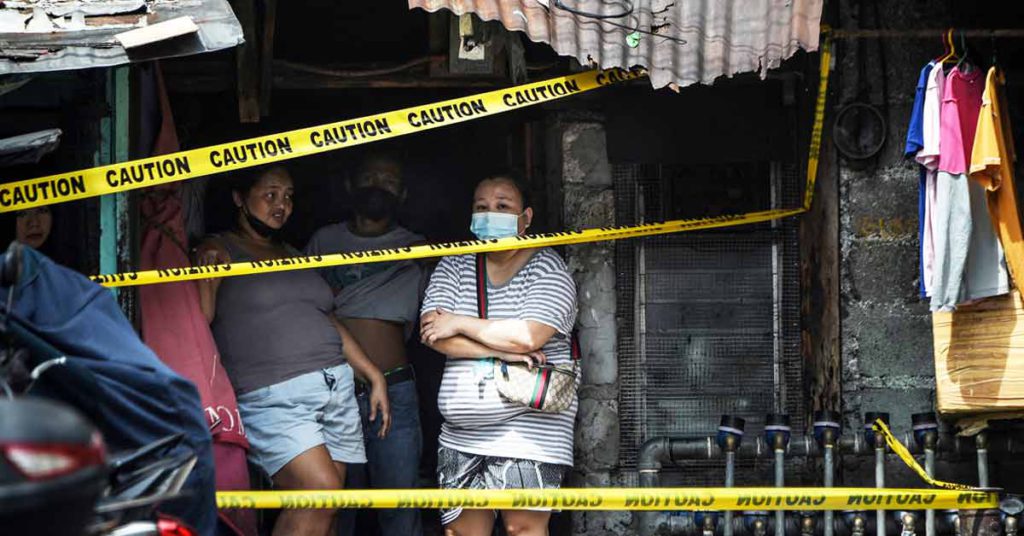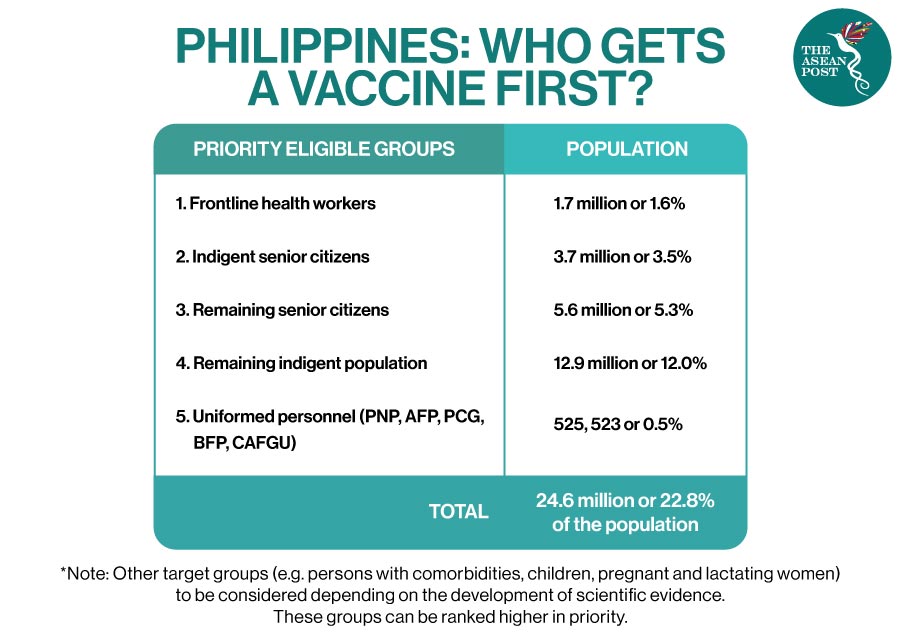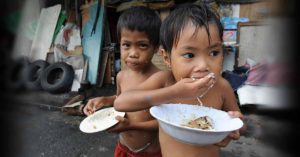
In the last couple of days, the Philippines has been experiencing a surge in the number of COVID-19 cases most especially in the National Capital Region (NCR). On 20 March 2021, the Department of Health (DOH) recorded one of the highest spikes in new cases of the coronavirus in one day, reaching 7,999 new cases with 597 recoveries and 30 deaths on the same day.
As of 20 March 2021, the total number of COVID-19 active cases in the country stood at 80,642, which is equivalent to 12.3 percent of the total cases (656,056) reported in the country to date. Out of these active cases, 97.5 percent are mild and asymptomatic cases; 0.9 percent are critical cases; 1.0 percent are severe; and 0.53 percent are moderate cases.
The percentage of deaths out of the total number of COVID-19 cases in the country is 1.97 percent or 12,930. Whereas, the percentage of recoveries out of the total cases is at 85.7 percent, or 562,484.
The top four regions in the country with active COVID-19 cases as well as the highest number of new active cases are the NCR, followed by Region IV-A (Calabarzon); Region VII (Central Visayas); and Region III (Central Luzon).
The reproduction number (Rt) was around two (2) early on in the surge/outbreak of COVID-19 cases. Meaning that each confirmed person with COVID-19 is infecting two other people – a bit higher than the prescribed Rt by the World Health Organization (WHO).
Silver Linings
Although there has been a surge in the number of COVID-19 cases over the last couple of days, among the silver linings, are (a) a low fatality/mortality rate; (b) the consistent increase in the number of recoveries; (c) the higher percentage of mild cases as opposed to severe, critical and even moderate cases; (d) the increased capacity in terms of testing and contact-tracing; (e) increased capacity of the healthcare system especially in terms of treating moderate, severe and critical COVID-19 cases; (f) increase in the number of isolation and testing centres; and (g) the availability of limited doses of COVID-19 vaccines.
The Philippines is not the only country struggling with a surge in new COVID-19 cases. Other countries are experiencing this as well.
For instance, countries that have avoided spikes in COVID-19 previously are now experiencing a surge in cases for the first time. Similar to the Philippines, spikes in new infections are also occurring in developed countries that have been administering COVID-19 vaccines to their respective populations for several weeks already like the United States (US) and France.
According to the WHO Representative to the Philippines, Dr Rabindra Abeyasinghe, this surge in COVID-19 cases is not only happening in the Philippines but has been observed in other parts of the world.
Dr Abeyasinghe said, “I want to emphasise that the Philippines is not unique in the fact that we are seeing an increase in cases. It appears to be something that has been affecting many countries across the world. It demonstrates the fact that COVID-19 still remains a new disease which we need to understand and the challenges that it poses and how we respond to the pandemic continues to evolve.”
Dr Abeyasinghe also said that one of the possible causes of the rise in COVID-19 infections was “vaccine optimism,” a phenomenon that was observed in countries where the rollout of vaccines for COVID-19 has begun. The WHO representative added that another possible reason for the surge in cases is the increased transmissibility of new variants of the SARS-CoV-2 virus that causes COVID-19.
These coronavirus variants have already been detected in the country and include the B.1.1.7 variant originally found in the United Kingdom (UK), the B.1.351 variant identified in South Africa, and the P.1 variant identified in Brazil. These variants are still being studied, while the local variant of the virus has not been observed to have “any increase in transmissibility.”
Nevertheless, for the Philippines, this surge in cases already serves as a warning. The country has to work on lowering the Rt to less than 1, which would mean that, on average, an infected person is infecting less than one person, eventually stopping the transmission of the virus.
This can only be made possible if the minimum health protocols prescribed by the DOH and the Philippine government like social distancing, wearing of face masks and face shields, washing of hands as often as possible, and staying at home are followed strictly. This is important as there’s still a relatively limited supply of COVID-19 vaccines in the country, and vaccinations are limited to healthcare workers currently.
Vaccine Rollout
Speaking of the COVID-19 vaccine roll-out in the Philippines, as of 15 March, 2021, out of the 1,125,600 COVID-19 vaccine doses available, the number of doses distributed is at 96 percent already or 1,079,400 doses in 929 vaccination sites across the country. Out of the 1.7 million health workers in the Philippines, more than 200,000 have received their first dose and this is increasing by the day.
However, just like other least developed and developing countries in Africa, Asia, and Latin America, the Philippines is struggling to swiftly secure and procure the necessary doses of COVID-19 vaccines to inoculate 50 to 70 percent of its population to achieve herd immunity. This is not necessarily because it doesn’t have the financing needed to procure the needed vaccines but because there’s a limited supply of vaccines available to countries in the least developed and developing world.

According to National Task Force (NTF) Against COVID-19 chief implementer and COVID-19 Vaccine Czar Carlito Galvez Jr., the delay in the acquisition of COVID-19 vaccines can be attributed to problems, shortages, and limitation of supply.
He said, “there is a problem in the global supply. Even if we have the funds, we cannot get them yet because high demand of the global supply. Kahit magkalkal tayo sa lupa wala pang dadating (even if we dig the soil/land, nothing will arrive yet).”
Since the country’s fight against the coronavirus pandemic intensified, securing COVID-19 vaccines has become the main priority for the Philippine government. However, a global vaccine supply shortage and hoarding of vaccines by rich western countries have made the sourcing of vaccines a complicated and difficult process. Rich nations representing a sixth of the global population have snatched-up about 70-75 percent of COVID-19 vaccine supplies available in 2021. There are just about 10 countries thus far which have administered more than 75-80 percent of COVID-19 vaccinations. The United Nations (UN) has called this a moral catastrophe.
Nevertheless, despite the difficulty in acquiring and securing COVID-19 vaccines, the Philippine government is finding ways to acquire and secure the necessary vaccines for its population. According to Galvez, in the next two-to-three weeks, the country will receive 400,000 doses of Sinovac as an addition to the initial 600,000 doses donated by the Chinese government.
Also, the country is awaiting delivery of the one million doses of Sinovac which it has purchased. Likewise, the Philippines is also expecting around 979,000 doses of AstraZeneca from COVAX. Hence, in the next couple of weeks, the Philippines will receive around 2.3 million doses of COVID-19 vaccines for the immunisation of its healthcare workers and other prioritised segments of the population.
Furthermore, the Philippines is expected to receive five to eight million doses of vaccines by May, which include private sector-procured vaccines. Just recently (18 March), the Philippine government and the private sector signed a tripartite agreement with Moderna for the supply of seven million doses of COVID-19 Moderna vaccine to the country. This is on top of the 13 million doses specified in a separate supply agreement between the Philippine government and the pharmaceutical company.
As the delivery of COVID-19 vaccines to the country from various manufacturers gains momentum, the government is targeting to inoculate one million Filipinos weekly in April, two million weekly in May, and at least three to five million weekly from July onwards.
Interventions
Aside from the many interventions already in place to address the surging number of COVID-19 cases in the Philippines, the government has spearheaded a “free face mask distribution project” in various regions of the country.
As of March 18, 2021, around 11,088,649 pieces of cloth masks have been distributed by the Department of Social Welfare and Development (DSWD) in Metro Manila, in Region III, Region IV-A, Region VI, Region VII, and Region XI. Also, around 1.5 million pieces of free face masks will be turned-over in Cavite and one million pieces of face masks will also be distributed in Rizal in the coming weeks.
Isolation Czar and Public Works and Highways Secretary Mark Villar reported that there are now 602 COVID facilities with a total 22,352-bed capacity and that by next month (April), the number of COVID facilities is targeted to be at 720 with 26,099 beds. Secretary Villar also said that the pop-up hospital at the Quezon Institute with 110 beds will be operational soon to help increase bed capacity for COVID-19 cases.
Regarding, testing, NTF Deputy Implementer and Testing Czar Secretary Vivencio Dizon reported that as of 19 March, 2021, there are now 229 laboratories, and that actual tests per day are now at 50,294 as of March 2021. Secretary Dizon also said that there are now 9.5 million tests that have been done and that the target of 10 million tests by the first quarter of 2021 will be achieved soon, especially with the availability of new saliva-based testing.
Whereas, Treatment Czar and Health Undersecretary Leopoldo Vega said that compared to last year, the standard of care, treatment, and experience in handling COVID-19 patients has improved. Vega said that despite an increase in cases, the country now has improved health systems’ capacity to address whatever may happen in the current COVID-19 situation.
Conclusion
Thus far, there’s not a single country that has declared itself successful in its fight against the pandemic other than China. Even then, China is still very much on its toes monitoring its COVID-19 situation because of the unpredictable nature of the virus.
Filipinos can help to contain the surge in COVID-19 cases in the country. They should exercise their shared responsibility of helping to control and put a stop to the surge in COVID-19 cases by being vigilant; following the minimum health standards/protocols prescribed by the WHO, and participating in the government’s national vaccination program.
Filipinos should unite to win the fight against COVID-19 to ensure the safety of all Filipinos and the country in general.
Source: The ASEAN Post
https://theaseanpost.com/article/philippines-fighting-new-covid-surge



